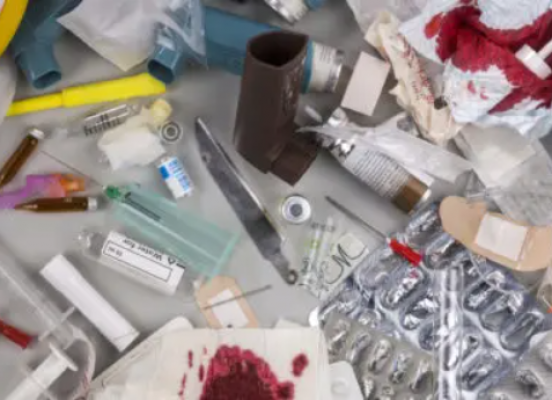Different Types of Medical Waste
There are many different types of medical waste, categorized largely by the types of materials uses and the waste disposal methods. In general, in the UK medical waste is separated into two main types: hazardous and non-hazardous. In the US and other parts of the world, there are four major types of medical waste: General, Infectious, Hazardous, and Radioactive.
Many of the same types of medical waste have different names that can be used interchangeably, depending on which country you are operating in.
![medical waste types]() What is medical waste?
What is medical waste?
Medical waste is any waste that is generated as a by-product of healthcare work at doctor’s surgeries, dentists, hospitals, and laboratories. It includes any material that could come into contact with the body during diagnosis, research, drug administration, or any type of treatment.
It’s likely to be infectious, or potentially infectious, and is often contaminated with bodily fluids in some way – but the term can also be used to refer to general waste from any medical practice, as well as specific waste streams typically found in the medical industry.
World Health Organisation (WHO) medical waste classifications:
The WHO has issued its own guidelines on the different types of medical waste, which include:
- Infectious Waste – Anything that’s infectious or contaminated
- Sharps – Waste like needles, scalpels, broken glass and razors
- Pathological Waste – Human or animal tissue, body parts, blood and fluids
- Pharmaceutical Waste – Unused and expired drug or medicines, like creams, pills, antibiotics
- Genotoxic Waste – Cytotoxic drugs and other hazardous toxic waste, that’s carcinogenic, mutagenic, or teratogenic.
- Radioactive Waste – Any waste containing potentially radioactive materials
- Chemical Waste – Liquid waste, typically from machines, batteries and disinfectants
- General/Other Waste – All other, non-hazardous waste.
Understanding the most common types of medical waste
Although there are several ways to categorize and name medical waste, the different medical waste streams are all fairly similar. Once you understand the types of waste within each, you can ensure each type is disposed of correctly.
For example:
- All needles, scalpels, razor blades, and any other sharp objects are generally referred to as Sharps. How they have been used will determine which type of medical waste they are categorized as – generally infectious, or
- Anybody parts, human tissue, or bodily fluid – as well as swabs and cultures – is typically referred to as anatomical or This is generally known as biohazard waste.
- The vast majority of medicines can be categorized into general pharmaceutical or medical waste – unless they are cytotoxic or cytostatic.
- Gloves, aprons, gowns, and used plastic packaging (like empty syringes and IVs), bandages, and gauzes will be hazardous/offensive waste – if the patient isn’t infected with any disease (also known as trace-chemotherapeutic waste), or it will be designated infectious waste if there is a risk of contamination.

Medical or clinical sharps yellow waste container
Separating medical waste streams for safe disposal
It is vital to understand the different types of medical waste and separate them accordingly, to protect healthcare workers and other patients and to dispose of the waste safely and effectively.
Different types of medical waste require different disposal techniques to ensure that any infectious materials cannot contaminate or spread to other areas.
Some general medical waste can be disposed of in landfills. Some require special treatment such as a medical incinerator.
The vast majority of medical waste must be incinerated to ensure that all traces of infections or pathogens are destroyed.
To know more, please check Inciner8.


 What is medical waste?
What is medical waste?